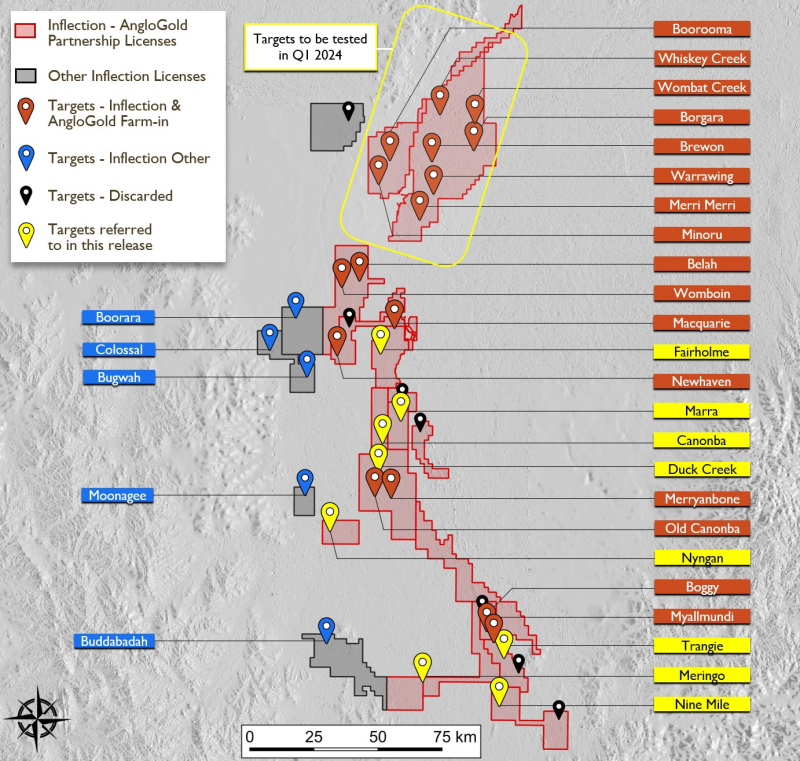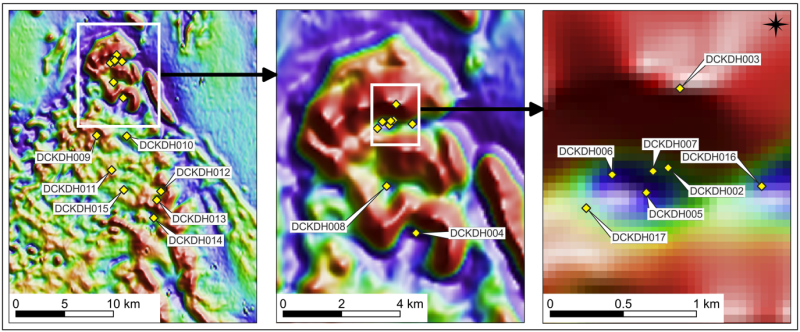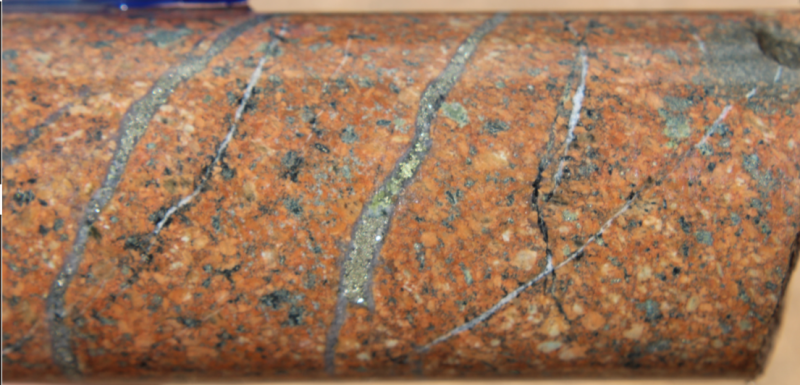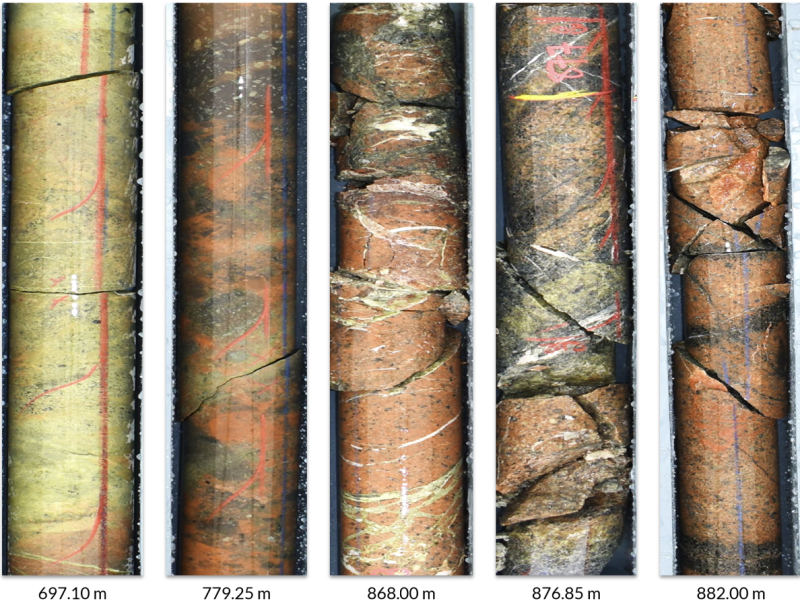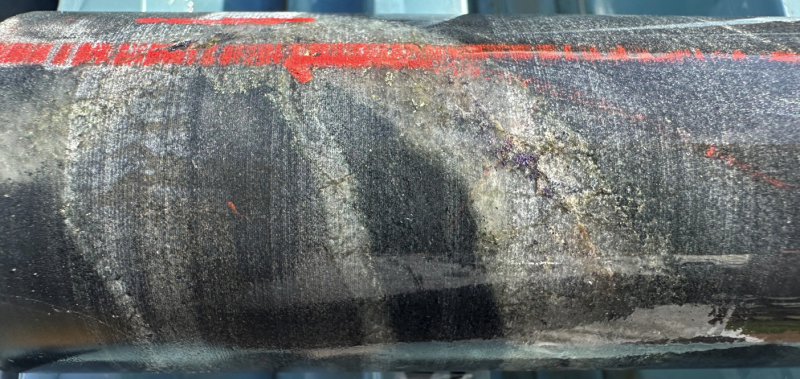Inflection Resources Provides Further Update on Drilling in New South Wales
Vancouver, British Columbia – TheNewswire – December 20, 2023: Inflection Resources Ltd. (CSE:AUCU) (OTC:AUCUF) (FSE:5VJ) (the “Company” or “Inflection”) is pleased to provide an update on its ongoing drill program in New South Wales, Australia conducted under the Exploration Agreement with AngloGold Ashanti Australia Limited (“AngloGold”) announced on June 14, 2023.
Summary Highlights:
- Recent drilling has focused on eight principal target areas: Duck Creek, Fairholme, Canonba, Nine Mile, Meringo, Nyngan, Trangie and Marra;
- An additional 6,636 metres comprising 16 holes was drilled, bringing the total to 13,524 metres and 30 holes completed thus far under the AngloGold Agreement;
- Favourable hydrothermal alteration, interpreted to be associated with an alkalic copper-gold porphyry system has been intercepted in deeper drill holes in the Duck Creek target. Drill hole DCKDH017 intercepted an extensive zone of inner propylitic hydrothermal alteration dominated by well-developed fracture-controlled to pervasive hematite – epidote – chlorite ± calcite alteration with lesser and variable amounts of magnetite, tourmaline, actinolite, pyrite, chalcopyrite and locally, bornite mineralisation. This style of inter propylitic alteration is often found in proximity to other alkalic porphyry systems in New South Wales and elsewhere;
- Initial scout drilling into the Fairholme target intercepted a sequence of strongly deformed, fine-grained, biotite bearing rocks with localised chalcopyrite ± bornite-bearing quartz veins; and,
- Recent drilling at Duck Creek, Myallmundi and Fairholme was reviewed by Inflection Technical Advisor Dr. Alan Wilson who is an Economic Geologist and a specialist in alkalic porphyry systems worldwide. Dr. Wilson completed the first PhD on Newmont’s Cadia Valley porphyry gold-copper deposits located in the Macquarie Arc and which remains one of Australia’s largest copper-gold mines.
Alistair Waddell, Inflection’s President and CEO, states: “The Company is very happy with the ongoing drill campaign in New South Wales and to have drilled the most extensive zone of alteration on the Duck Creek project to-date. We are particularly encouraged with the extent and intensity of favourable hydrothermal alteration in drill hole DCKDH017, which is interpreted to be inner propylitic domain dominated by pervasive hematite with lesser and variable amounts of magnetite, tourmaline, actinolite, pyrite, chalcopyrite and bornite. This style of alteration is often found directly adjacent to copper-gold mineralization in other Alkalic porphyry systems found worldwide. The Company is also highly encouraged with the first hole into the Fairholme target. There are still many geological questions to be answered, including the age of mineralisation, but we are happy to have intercepted chalcopyrite-bornite bearing quartz veins with the first hole into this specific target area. The Company is looking forward to follow-up drilling as well as continuing the program of first-pass scout drilling in the New Year on the large portfolio of drill targets”.
Duck Creek – Drilling:
Two deep drill holes (DCKDH016 and 017) totalling 1,401.8 metres have recently been completed on the northern Duck Creek exploration license (Figures 1 and 2). The two holes are located approximately 1,200 metres apart and tested two distinct, circular magnetic lows.
The Company considers the Duck Creek exploration license to be highly prospective for large-scale alkalic porphyry-related copper-gold style deposits related to favourable magnetic and gravity features within part of the prospective Macquarie Arc volcanic sequence. Inflection drilling intersected strongly hydrothermally altered rocks with characteristics similar to those found adjacent to mineralised alkalic copper–gold systems such as Newmont’s Cadia mine (Cadia East and Ridgeway deposits) and the Northparkes mine complex. In addition to strong inner propylitic alteration, chalcopyrite and blebs of bornite are locally associated with biotite-albite-K-feldspar-tourmaline potassic alteration.
Figure 1: Target location map, northern New South Wales
The geology of the northern Duck Creek target consists of andesitic volcanics, comprising both polymictic volcanic breccias/conglomerates and massive andesites that are likely to be both lava flows and subvolcanic intrusions. Equigranular to weakly porphyritic hornblende-bearing monzonite to quartz monzonite occur in holes DCKDH016 (east side of target area – Figure 3) and DCKDH017 (west side of target area – Figure 4) and are interpreted to be pre-alteration in timing due to their largely equigranular groundmass and variably altered nature. Hydrothermal alteration intercepted to-date at Duck Creek is dominated by inner propylitic assemblages and shows the following characteristics and distribution:
- Well-developed fracture-controlled to pervasive hematite–epidote–chlorite ± calcite alteration with lesser and variable amounts of magnetite, tourmaline, actinolite, pyrite, chalcopyrite and locally, bornite, is widespread in holes DCKDH007 and DCKDH017 (Figure 4);
- Porous and permeable volcaniclastic units are commonly pervasively altered to the above assemblage whilst massive and broadly impermeable andesites are subject to fracture-controlled and pervasive inner propylitic alteration; and,
- Mineralisation associated with this alteration comprises minor disseminations and clots of pyrite, chalcopyrite and locally, bornite.
In the context of the known alkalic porphyry copper-gold deposits of the Early Silurian Cadia district, inner propylitic alteration is documented to extend 100 to >400 metres away from the transition from this assemblage to copper-gold bearing potassic and calc-potassic alteration at the high grade Ridgeway deposit, whilst at the Cadia East deposit, the inner propylitic alteration extends for up to 400 metres from mineralised potassic alteration in the hanging wall of this inclined porphyry deposit. In both instances, porphyry-related quartz veining is reportedly very minor to absent in areas of inner propylitic alteration.
Figure 2: Duck Creek drill hole location map on background RTP magnetics.
Figure 3: Duck Creek diamond drill core – Hole DCKDH016 – 398.50 metres. Hematite altered quartz monzonite with quartz-pyrite-chalcopyrite veining. Hole was drilled to a depth of 506.7 metres in an easterly direction (091º) with a dip of -70º.
Figure 4: Select Duck Creek diamond drill core – Hole DCKDH017. Drilled to a depth of 895.1 metres in an east-north-easterly direction (080º) and a dip of -70º. NQ sized core shows a variety of different inner propylitic alteration styles.
See link here for high resolution DCKDH017 core photos from the entire hole. DCKDH017 – Inflection Resources
The Company is still awaiting many assay results from the laboratory, as well as key geochronology samples, green rock analysis, petrographic and spectral studies, all of which need to be reviewed and incorporated into our evolving geological model where we will apply a large-scale, systems-thinking approach to the ongoing drill targeting.
Duck Creek – Geophysical Surveys:
Three separate geophysical surveys have been completed on the Duck Creek exploration license including Ambient Noise Tomography (ANT), an Induced Polarisation/Magnetotellurics (IP/MT) survey and a ground gravity study. All data has now been received and the results of the surveys are currently being interpreted by Inflection and AngloGold in conjunction with Perth based consultants Mira Geoscience. Results of the integrated surveys will be released in the new year although preliminary indications are the ANT and gravity surveys have worked very well and the IP/MT did not appear to penetrate the post-mineral sedimentary cover.
Fairholme – Drilling:
One drillhole (FARDH002) totalling 534.3 metres was completed on the Fairholme target. The hole was designed to test the margin of a distinct magnetic high. Rocks in this hole are mainly fine-grained, biotite-bearing, variably deformed and locally brecciated often cemented by a fine-grained quartz diorite porphyry. The rock is cut by strongly deformed quartz veins that locally contain abundant chalcopyrite and lesser bornite (Figure 5).
Whilst difficult to decipher, these rocks are interpreted by Inflection to be fine-grained volcaniclastics with associated biotite, chalcopyrite ± bornite-bearing quartz veins that have experienced upper greenschist facies metamorphism and structural deformation. The Company is still awaiting the assays, several petrographic samples as well as a key geochronology sample before planning any additional drilling.
Figure 5: Drill hole FARDH002 – 501 metres – Quartz–chalcopyrite–bornite veins that display ductile folding.
Nine Mile:
Five drillholes (NMLDH005-009) totalling 1,446 metres were completed on the Nine Mile target. The five holes were drilled to test a variety of different geophysical targets. Holes NMLDH005 and NMLDH009 intersected weak to moderately chlorite-epidote altered and magnetic feldspar porphyritic andesite. Drill hole NMLDH006 intersected well bedded siltstone and holes NMLDH007 and NMLDH008 intersected magnetic, unaltered equigranular diorite. Assays are pending although no values of economic interest are anticipated.
Meringo:
One drillhole (MERDH004) totalling 450 metres was completed on the Meringo target. The hole was drilled to test a large aeromagnetic complex inferred to represent a zone of magnetite enrichment, associated with porphyry-copper-gold mineralisation below unconformable Devonian to Silurian limestones. Beneath the limestones the hole intercepted highly magnetic, unmineralized megacrystic andesites interpreted to be lava flows. Assays are pending although no values of economic interest are anticipated and no further work is planned on the Meringo target.
Trangie:
Four drillholes (TRNDH019, 020, 021, 022) totalling 1,980 metres were completed on the Trangie target to step-out from previous holes which intersected intense epidote-albite alteration and elevated porphyry-related path-finder elements. The four holes all intersected an intercalated sequence of moderate chlorite and weak-moderate epidote altered volcaniclastic sediments and andesites. A full review of these and all previous holes will be completed prior to planning any additional holes into this target. Assays have only been received for drill hole TRNDH019 which returned maximum values of 2 metres at 0.23% Cu and 0.09 g/t Au from 433 metres. Assays from all other holes are pending.
Nyngan:
One drillhole (NYNDH001) totalling 169.9 metres was completed on the Nyngan target. The hole tested the margin of a distinct magnetic high and intercepted a mixed package of epidote and haematite altered andesites and andesitic volcaniclastics with patchy disseminated pyrite and occasional quartz veins. Assays are pending.
Canoba:
One drillhole (CANDH001) totalling 474.5 metres was completed on the Canoba target. The hole tested a discreet aeromagnetic high and intersected intercalated chlorite altered siltstone and epidote altered magnetic andesite. Assays are pending although no values of economic interest are anticipated, and no further work is planned on the Canoba target.
Marra:
One drill hole (MARDH003) was drilled on the Marra target to a depth of 190 metres to test a distinct, circular magnetic low. Drilling intersected a heavily fractured, flow-banded, hematite-sericite altered quartz-alkali feldspar trachyte. Assays are pending although no values of economic interest are anticipated, and no further work is planned on the Marra target.
Drilling Plans Going Forward:
The Company is still awaiting a large number of assay results from the laboratory, as well as key geochronology samples, green rock analysis, petrographic and spectral studies, all of which will be incorporated into our evolving geological models for the various targets including Duck Creek and Myallmundi. Early in the new year while awaiting all the various results, drilling will initially focus on the northern-most targets, specifically, Newhaven, Whiskey Creek, Wombat Creek, Boorooma, Borgara, Brewon, Warrawing, Merri Merri and Minoru (Figure 1).
AngloGold Exploration Agreement Terms:
All the work programs noted above form part of the AngloGold Ashanti Exploration Alliance where AngloGold is sole funding up to AUD$10,000,000 on exploration expenditures across a wide range of different intrusive related exploration targets over a maximum 36-month period, which includes a minimum expenditure commitment of AUD$6,000,000. Inflection is operating Phase I and is receiving a 10% management fee for doing so. Upon completion of Phase I, AngloGold then retains the right to designate up to five individual projects where it may potentially earn up to a 75% interest in each by completing various milestones. See Inflection news release dated June 14, 2023 for further details. https://inflectionresources.com/inflection-resources-and-anglogold-ashanti-sign-definitive-exploration-agreement-across-portfolio-of-copper-gold-projects-in-australia/
About Inflection’s NSW Projects:
The Company is systematically exploring for large copper-gold and gold deposits in the northern interpreted extension of the Macquarie Arc, part of the Lachlan Fold Belt in New South Wales. The Macquarie Arc is Australia’s premier porphyry copper-gold province host to Newmont’s Cadia deposits, the CMOC Northparkes deposits and Evolution Mining’s Cowal deposits plus numerous exploration prospects including Boda, the discovery made by Alkane Resources.
The Company uses cost-effective mud-rotary drilling to cut through unmineralised post-mineral sedimentary cover before changing to diamond core drilling once basement is reached. It is well documented that mineralised bodies elsewhere in the belt, in particular porphyry and intrusive related systems, have large district-scale alteration and geochemical halos or footprints surrounding them. The Company typically completes a series of short diamond drill holes into bedrock rather than just one or two deep and more expensive diamond drill holes. Multiple data points gained from alteration and mineral geochemistry is then used to vector additional deeper holes. This is a proven exploration strategy in the covered segments of the Macquarie Arc having been directly responsible for the discovery of the Northparkes and Cowal deposits.
Qualified Person and Sampling Quality Control:
The scientific and technical information contained in this news release has been reviewed and approved by Mr. Carl Swensson (FAusIMM), a “Qualified Person” (“QP”) as defined in National Instrument 43-101 – Standards of Disclosure for Mineral Projects.
Drilling is being conducted using a truck-mounted multi-purpose drill rig. Mud rotary drilling is utilised to drill through the cover sequence before transitioning to diamond drilling using NQ sized core at the unconformity. Core is logged at the Company’s field office, photographed and marked before being cut to the Company’s specified sample intervals. Half core samples are placed in bags with internationally certified blanks and standards inserted. Samples are dispatched to ALS Laboratories in Orange NSW, an accredited analytical laboratory meeting ISO/IEC 17025:2005 and ISO 9001:2015. Samples are prepared by crushing and grinding via ALS methods CRU-21 and PUL-32 respectively. The pulps are then assayed for 48 elements via ALS method ME-MS61 using a 25g sample after a four acid near total digest with an ICP-MS finish. Gold is assayed by fire assay using ALS method Au-AA23 using a 30g sample charge and AAS finish. Laboratory standards and QA-QC are monitored by the Company. Coarse rejects from the sample preparation are subjected to spectral analysis.
About Inflection Resources Ltd. Inflection is a technically driven copper-gold and gold focused mineral exploration company listed on the Canadian Securities Exchange under the symbol “AUCU” and on the OTCQB under the symbol “AUCUF” with projects in Australia. For more information, please visit the Company website at www.inflectionresources.com.
Inflection is part of the NewQuest Capital group which is a discovery-driven investment company that builds value through the incubation and financing of mineral projects and companies. Further information about NewQuest can be found on the company website at www.nqcapitalgroup.com.
On behalf of the Board of Directors
Alistair Waddell
President and CEO
For further information, please contact:
Brennan Zerb
Investor Relations Manager
+1 (778) 867-5016
Forward-Looking Statements: This news release includes certain forward-looking statements and forward-looking information (collectively, “forward-looking statements”) within the meaning of applicable Canadian securities legislation. All statements, other than statements of historical fact, included herein including, without limitation, statements regarding future capital expenditures, amount of drilling, receipt of the maximum amount of available grant funding, anticipated content, commencement and cost of exploration programs in respect of the Company’s projects and mineral properties, AngloGold’s anticipated funding of the Minimum Commitment and timing thereof, and the anticipated business plans and timing of future activities of the Company, are forward-looking statements. Although the Company believes that such statements are reasonable, it can give no assurance that such expectations will prove to be correct. Often, but not always, forward looking information can be identified by words such as “pro forma”, “plans”, “expects”, “may”, “should”, “budget”, “scheduled”, “estimates”, “forecasts”, “intends”, “anticipates”, “believes”, “potential” or variations of such words including negative variations thereof, and phrases that refer to certain actions, events or results that may, could, would, might or will occur or be taken or achieved. Forward-looking statements involve known and unknown risks, uncertainties and other factors which may cause the actual results, performance or achievements of the Company to differ materially from any future results, performance or achievements expressed or implied by the forward-looking statements. Such risks and other factors include, among others, statements as to the anticipated business plans and timing of future activities of the Company, including the Company’s exploration plans. the proposed expenditures for exploration work thereon, the ability of the Company to obtain sufficient financing to fund its business activities and plans, delays in obtaining governmental and regulatory approvals (including of the Canadian Securities Exchange), permits or financing, changes in laws, regulations and policies affecting mining operations, the Company’s limited operating history, currency fluctuations, title disputes or claims, environmental issues and liabilities, as well as those factors discussed under the heading “Risk Factors” in the Company’s prospectus dated June 12, 2020 and other filings of the Company with the Canadian Securities Authorities, copies of which can be found under the Company’s profile on the SEDAR website at www.sedar.com. Readers are cautioned not to place undue reliance on forward-looking statements. The Company undertakes no obligation to update any of the forward-looking statements, except as otherwise required by law.
Copyright (c) 2023 TheNewswire – All rights reserved.



